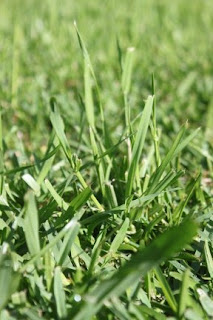These are only the spring weeds -- I've just barely begun to see the summer rascals. Here's a nutsedge, my ancient old enemy. He's up early this year, trying to intimidate me. My nutsedge grows in amongst the liriope, where I can't use sprays.
Far more common so far are the dandelions. I can usually get to them before they flower and go to seed, but this year, I think they are winning. They often get so much bigger before they flower, but I think they must be in a hurry this year.
 This may not be a weed to you, but it is to me. I called it Accursed Mistflower. I planted these in a fit of perennial frenzy years ago, and they've reseeded and spread all over my yard ever since. They look a whole lot like Mulberry seedlings, which I also have in great abundance. The top one is Accursed Mistflower and the bottom one is Mulberry, planted by flocks of cedar waxwings that come to my neighbor's tree for the fruits.
This may not be a weed to you, but it is to me. I called it Accursed Mistflower. I planted these in a fit of perennial frenzy years ago, and they've reseeded and spread all over my yard ever since. They look a whole lot like Mulberry seedlings, which I also have in great abundance. The top one is Accursed Mistflower and the bottom one is Mulberry, planted by flocks of cedar waxwings that come to my neighbor's tree for the fruits.
Of course, I have my own tree seedlings to worry about. My lovely Drummond Red Maple is a prolific seeder. You can see even in the tiniest seedling the telltale red stem. I think the baby pecan trees underneath are way too far advanced to be called seedlings!
Here's a weed we all love to hate. This is Virginia Buttonweed, which likes to hide under all sorts of things, spreading its tendrils all over the flowerbeds. It's hard to remove because the stems break so easily and it seems to root from even the tiniest piece.
I realized when I was taking pictures that I knew just where to look for the dollarweed. It doesn't say much about my garden hygiene, does it? Dollarweed has seized a corner of the bed and refuses to yield.
And the battle rages on with the white proso millet, which I planted myself, it seems, directly from the birdfeeder. It grows so much like the lawn that I can only see it about 5 or 6 days after we mow. Then I have to rush to pull it, before the lawn is mown again.
Bermudagrass is everywhere present, though not really a major problem anywhere. It jumps up from time to time but seems relatively easy to take care of, as long as I stay on top of it.
I wish the same could be said for oxalis, which grows everywhere. It's too plentiful for me to spray and if you've ever tried to pull it out, you know it just can't be done. It separates so easily from the rootlets and corms, which sprout up again. I'm trying to learn to like it for its pretty pink flowers, but it's not working.
And the prize for ugliest weed of the day goes to sow thistle! Easy to remove but once it gets big it's disgraceful in the lawn.
This isn't even all of them! I didn't put in pictures of the purplish mat-forming weed that likes to grow in the gravel paths, or the prickly shrub-like weed that sneaks up into the indigofera. Or the little one that looks like it's halfway between a grassy and a broadleaf weed. Oh well! More for another day.
For more information about weeds, I like the Weed Alert site.

























.jpg)




